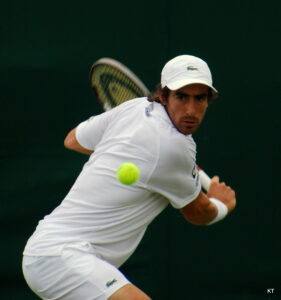Get Sideways and Stay Sideways
Stand on the baseline facing the back fence of the court to practice the motion for a backhand. This will free you from worrying about where the ball lands as you practice the motion.
Practicing turning your shoulders so your opponent can see your back. Keeping them turned as you bring the racquet forward until your racquet and your swing open your torso. Don’t swing by turning your shoulders – your racquet path should be toward the opposite back fence, not the side fence on your racquet arm.
In short, swing north to south with your arm, not west to east (for a right-hander). Your racquet will eventually travel to your side, but only after you hit the ball. Your shoulder should push your racquet forward – your racquet should not pull your shoulder forward.
Open Your Hips on a Backhand
Make sure you use all the power in your hips to open yourself up. Using your hips to help open up will help you avoid using your shoulders to open you up. After you take your racquet back, start your forward swing by slightly accelerating your hips. This will help you hit north to south, rather than east to west.
Use Two Hands for Balance
Even though you’re using a one-handed backhand, you need your second hand for balance. Keep both hands on the racquet as you take it back, then release the non-hitting hand as you get ready to strike the ball.
If you don’t do this, you won’t close your shoulders enough and you’ll end up with an west-to-east swing, or with your elbow leading. This will cause you to hit only with your forearm, and could give you tennis elbow.
Practice Backhands from the Service Line
Move to the service line, facing the net, and have your partner feed balls to you from the opposite service line. Practice hitting balls left and right. Move halfway between the service line and baseline after 20 or more practice shots and have your partner do the same. Continue practicing your swing.
Practice footwork at this point by stepping toward the net before you hit the ball, rather than stepping across your body toward the service line. Have your partner feed balls that make you move at least two steps left, forward or diagonally forward.
Move to the Baseline
The final step as you learn how to hit an easy one-handed backhand is to move to the baseline. Have your partner move to the opposite baseline to feed balls.
Practice hitting balls left and right, deep and short and while moving side to side and forward and back. Practice bending your knees as the ball is coming toward you and pushing up from the ground as you hit the ball.
What About Backhand Grips?
Experiment with grips, including moving the top knuckle on your right hand to the top bevel of the grip for an Eastern backhand grip, to get more topspin.
Use a Continental, or “shake hands” grip for one-handed slice backhands. Place your hitting hand flat against the face of the racquet (string bed). Slide your hand down to the grip and grip the racquet.
Check out these grip diagrams for more help.
